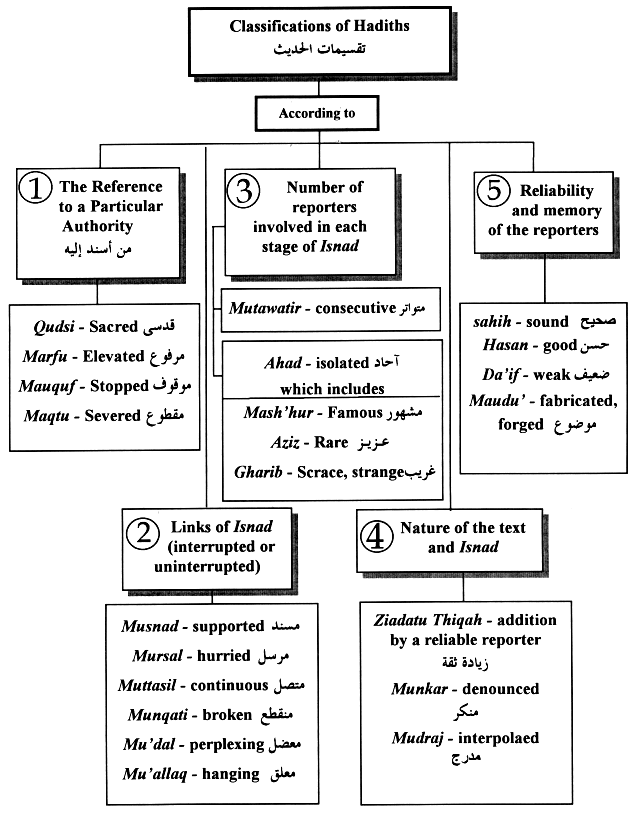The science of hadith is vast and there are many classifications and rankings of hadith. Here is a summary of the main types of classifications (tabaqat).
A hadith is composed of three parts:

The Matn is the main text whereas the Isnad is the chain of reporters leading back to the Prophet, and the Taraf is the beginning sentence of the matn which refers to the sayings, actions or characteristics of the Prophet, for example I saw or I heard.
Classifications Of Hadith
There are five majorways in which we can classify hadith.

Level of Authority
- Quḍsi – Divine; a revelation from Allah(SWT); relayed with the words of the Prophet.
- Marfu’ – elevated; a narration from the Prophet, e.g. I heard the Prophet(P) saying …
- Mawquf– stopped; a narration from a companion only, e.g. we were commanded to …
- Maqtu’ – severed: a narration from a Tabi’i (successor).

The links within the chain of hadith
- Musnad – supported; a hadith which is reported by a traditionalist, based on what he learned from his teacher at a time of life suitable for learning; similarly – in turn – for each teacher until the isnad reaches a well known companion, who in turn, reports from the Prophet.
- Muttaṣil – continuous; a hadith with an uninterrupted isnad which goes back only to a sahabi or tabi’.
- Mursal – hurried; if the link between the tabi’ and the Prophet(P) is missing, e.g. when a tabi’ says “The Prophet said…”.
- Munqaṭi` – broken; a hadith whose link anywhere before the tabi’ is missing.
- Mu’aḍal – perplexing: is a hadith whose reporter omits two or more consecutive reporters in the isnad.
- Mu’allaq – hanging: is a hadith whose reporter omits the whole isnad and quotes the Prophet directly (i.e., the link is missing at the beginning).
Number of reporters
- Mutawatir – Consecutive: is a hadith which is reported by such a large number of people (at least 10 at every level so 100 narrators) that they cannot be expected to agree upon a lie, all of them together.
- Aḥād – isolated: is a hadith which is narrated by people whose number does not reach that of the mutawatir. It is further classified into:
- Mašhūr – famous: hadith reported by more than two reporters.
- ‘Azīz – rare, strong: at any stage in the isnad, only two reporters are found to narrate the hadith.
- Gharīb – strange: At some stage of the isnad, only one reporter is found relating it.
Nature of the whole hadith
- Ziyādatu Thiqah – addition; by a reliable reporter
- Munkar – denounced; is a hadith which is reported by a weak narrator, and whose narration goes against another authentic hadith.
- Mudraj – interpolated; an addition by a reporter to the text of the hadith being narrated.
Reliability of the reporters
- Ṣaḥīḥ– sound; 1) Each narrator in the chain of narration must be trustworthy; 2) Each narrator must be reliable in his ability to preserve that narration, be it in his ability to memorize to the extent that he can recall it as he heard it, or, that he has written it as he heard it and has preserved that written document unchanged; 3) The isnād must be connected (muttasil) insofar as it is at least possible for each narrator in the chain to have received the hadith from a predecessor; 4) The hadith, including its isnād, is free of ʻillah (hidden detrimental flaw or flaws, e.g. the establishment that two narrators, although contemporaries, could not have shared the hadith, thereby breaking the isnād.) 5) The hadith is free of irregularity, meaning that it does not contradict another hadith already established (accepted).
- Ḥasan– good; authenticity is not as well-established as that of ṣaḥīḥ hadith in relation to the precision of the narrator.
- A Hadith can also be Sahih or Hasan due to other supporting factors but known as Sahih li Ghayrihi and Hasan li Gayrihi respectively.
- Ḍaʻīf – weak; a hadith which fails to reach the status of Hasan. Usually, the weakness is: a) one of discontinuity in the isnad, in which case the hadith could be – according to the nature of the discontinuity –Munqati (broken), Mu’allaq (hanging), Mu’aḍal (perplexing), or Mursal (hurried), or b) one of the reporters having a disparaged character, such as due to his telling lies, excessive mistakes, opposition to the narration of more reliable sources, involvement in innovation, or ambiguity surrounding his person.
- Mawḍūʻ fabricated or forged; is a hadith whose text goes against the established norms of the Prophet’s sayings, or its reporters include a liar. Fabricated hadith are also recognized by external evidence related to a discrepancy found in the dates or times of a particular incident.
